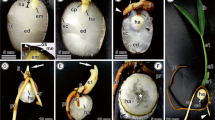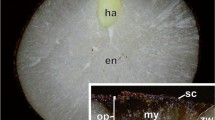Abstract
We evaluated the physiological and cytological aspects of the embryos of the palm tree Mauritia flexuosa, whose seeds show a rare association of recalcitrance and dormancy. Seeds were subjected to dehydration, or stored with stabilized water contents for 420 days. Seed viability and germination, as well as the anatomy, cytochemistry and ultrastructure of the embryos were evaluated using standardized methodologies. Under initial conditions (seeds with water contents of 44.6 %), viability was as high as 94 %, although without germination. Seeds dehydrated to water contents of 20 % lost all viability, whereas 87 % of the seeds stored while hydrated remained viable and 25 % germinated. Embryonic cells showed characteristics associated with recalcitrance in other palms species, such as the presence of large vacuoles and the absence of lipidic reserves, but also had abundant protein bodies and terpenoids in their cytoplasm as well as carbohydrate and protein reserves in their vacuoles—conditions found in the embryo cells of palms having orthodox seeds. Dehydration caused invagination of the cell walls, retraction of the plasma membrane, proliferation of the endoplasmic reticulum and autophagic vacuoles, and increased the densities of vacuolar contents—culminating in the collapse of the protoplast. Stored seeds showed preserved cell structures. M. flexuosa seeds are sensitive to dehydration, but will retain viability if kept hydrated, allowing dormancy to be overcome in seed banks in the swampy soils where this species occurs. The accumulations of secondary metabolites, vacuolation and the storage of carbohydrates and proteins in the vacuole all have important roles in the modulation of recalcitrance.








Similar content being viewed by others
References
Bailly C (2004) Active oxygen species and antioxidants in seed biology. Seed Sci Res 14:93–107
Baskin CC, Baskin JM (2014) Seeds: ecology, biogeography and evolution of dormancy and germination. Academic Press, San Diego
Berjak P, Pammenter NW (2000) What ultrastructure has told us about recalcitrant seeds. Rev Bras Fisiol Veg 12:22–55
Berjak P, Pammenter NW (2008) From Avicennia to Zizania: seed recalcitrance in perspective. Ann Bot 101:213–228
Bewley JD, Bradford KJ, Hilhorst HWM, Nonogaki H (2013) Seeds: physiology of development, germination and dormancy. Springer, New York
Brasil, Ministério da Agricultura, Pecuária e Abastecimento (2009) Regras para análise de sementes. Mapa/ACS, Brasília
Cho C-H, Cho T-P, Kuo-Huang L-L (2001) Ultrastructural study on the recalcitrant seeds of Machilus thunbergii Sieb. & Zucc. Taiwania 42:125–134
David R, Carde JP (1964) Coloration différentielle dês inclusions lipidique et terpeniques dês pseudophylles du Pin maritime au moyen du reactif Nadi. C R Hebd Séances Academ Sci Paris Série D 258:1338–1340
Daws MI, Garwood NC, Pritchard HW (2006) Prediction of desiccation sensitivity in seeds of woody species: a probabilistic model based on two seed traits and 104 species. Ann Bot 97:667–674
DeMason DA (1988) Embryo structure and storage reserve histochemistry in the palm Washingtonia filifera. Am J Bot 75:330–337
DeMason D, Thomson WW (1981) Structure and ultrastructure of the cotyledon of date palm (Phoenix dactylifera L.). Bot Gaz 142:320–328
Dickie JB, Balick MJ, Linington IM (1992) Experimental investigations into the feasibility of ex situ preservation of palm seeds; an alternative strategy for biological conservation of this economically important plant family. Biodivers Conserv 1:112–119
Dransfield J, Uhl NW, Asmussen CBA, Baker WJ, Harley MM, Lewis CE (2008) Genera palmarum: the evolution and classification of palms. Kew Publishing, Kew
Fahn A (1990) Plant anatomy, 4th edn. Pergamon Press, New York, pp 522–524
Farnsworth E (2000) The ecology and physiology of viviparous and recalcitrant seeds. Annu Rev Ecol Syst 31:107–138
Fintel GT, Berjak P, Pammenter NW (2004) Seed behaviour in Phoenix reclinata Jacquin, the wild date palm. Seed Sci Res 14:197–204
Fischer DB (1968) Protein staining of ribboned Epon sections for light microscopy. Histochemie 16:92–96
Gumilevskaya NA, Azarkovich MI (2007) Physiological and biochemical characteristics of the recalcitrant seeds having dormancy: a review. Appl Biochem Microbiol 43:332–340
Holm JA, Miller CJ, Cropper WP Jr (2008) Population dynamics of the dioecious amazonian palm Mauritia flexuosa: simulation analysis of sustainable harvesting. Biotropica 40:550–558
Hong TD, Ellis RH (1996) A protocol to determine seed storage behaviour. In: Engels JMM, Toll J (eds) IPGRI Technical Bulletin No. 1. International Plant Genetic Resources Institute, Rome
Horn CM, Gilmore MP, Endress BA (2012) Ecological and socio-economic factors influencing aguaje (Mauritia flexuosa) resource management in two indigenous communities in the Peruvian Amazon. For Ecol Manag 267:93–103
Johansen DA (1940) Plant microtechnique. McGraw-Hill Boo Company, New York
Karnovsky MJ (1965) A formaldehyde-glutaraldehyde fixative of high osmolality for use in electron microscopy. J Cell Biol 27:137–138
Kioko JI, Berjak P, Pammenter NW (2006) Viability and ultrastructural responses of seeds and embryonic axes of Trichilia emetica to different dehydration and storage conditions. S Afr J Bot 72:167–176
Koolen HHF, da Silva FMA, Gozzo FC, de Souza AQL, de Souza ADL (2013) Antioxidant, antimicrobial activities and characterization of phenolic compounds from buriti (Mauritia flexuosa L. f.) by UPLC–ESI-MS/MS. Food Res Int 51:467–473
Long RL, Gorecki MJ, Renton M, Scott JK, Colville L, Goggin DE, Finch-Savage WE (2015) The ecophysiology of seed persistence: a mechanistic view of the journey to germination or demise. Biol Rev 90:31–59
Lorenzi H, Kahn F, Noblick LR, Ferreira E (2010) Brazilian flora Lorenzi: Arecaceae (palms). Plantarum, Nova Odessa
Marty F (1999) Plant vacuoles. Plant Cell 11:587–599
Mazzottini-dos-Santos HC, Ribeiro LM, Mercadante-Simões MO, Sant’Anna-Santos BF (2015) Ontogenesis of the pseudomonomerous fruits of Acrocomia aculeata (Arecaceae): a new approach to the development of pyrenarium fruits. Trees 29:199–214
Moura EF, Ventrella MC, Motoike SY (2010) Anatomy, histochemistry and ultrastructure of seed and somatic embryo of Acrocomia aculeata (Arecaceae). Sci Agric 67:399–407
Neves SC, Ribeiro LM, Cunha IRG, Pimenta MAS, Mercadante-Simões MO, Lopes PSN (2013) Diaspore structure and germination ecophysiology of the babassu palm (Attalea vitrivir). Flora 208:68–78
O’Brien TP, Feder N, McCully ME (1964) Polychromatic staining of plant cell walls by toluidine blue O. Protoplasma 59:368–373
Oliveira NCC, Lopes PSN, Ribeiro LM, Mercadante-Simões MO, Oliveira LAA, Silvério FO (2013) Seed structure, germination, and reserve mobilization in Butia capitata (Arecaceae). Trees 27:1633–1645
Orozco-Segovia A, Batis AI, Rojas-Aréchiga M, Mendoza A (2003) Seed biology of palms: a review. Palms 47:79–94
Paiva EAS, Pinho SZ, Oliveira DMT (2011) Large plant samples: how to process for GMA embedding? In: Chiarini-Garcia H, Melo RCN (eds) Light microscopy: methods and protocols. Humana Press, Totowa, pp 37–49
Pammenter NW, Berjak P (2000) Aspects of recalcitrant seed physiology. Rev Bras Fisiol Veg 12:56–69
Pammenter NW, Berjak P, Farranta JM, Smitha MT, Rossa G (1994) Why do stored hydrated recalcitrant seeds die? Seed Sci Res 4:187–191
Panza V, Láinez V, Maldonado S (2004) Seed structure and histochemistry in the palm Euterpe edulis. Bot J Linn Soc 145:445–453
Panza V, Láinez V, Maldonado S, Maroder HL (2007) Effects of desiccation on Euterpe edulis Martius seeds. Biocell 31:383–390
Pizzolato TD, Lillie RD (1973) Mayer’s tannic acid ferric chloride stain for mucins. J Histochem Cytochem 21:56–64
Ribeiro LM, Oliveira TGS, Carvalho VS, Silva PO, Neves SC, Garcia QS (2012) The behaviour of macaw palm (Acrocomia aculeata) seeds during storage. Seed Sci Technol 40:344–353
Ribeiro LM, Garcia QS, Müller M, Munné-Bosch S (2015) Tissue-specific hormonal profiling during dormancy release in macaw palm seeds. Physiol Plant 153:627–642
Robards AW (1978) An introduction to techniques for scanning electron microscopy of plant cells. In: Hall JL (ed) Electron microscopy and cytochemistry of plant cells. Elsevier, New York
Roland AM (1978) General preparations and staining of thin sections. In: Hall JL (ed) Electron microscopy and cytochemistry of plant cells. Elsevier, New York
Seleguini A, Camilo YMV, Souza ERB, Simões MLM, Belo APM, Fernandes AL (2012) Superação de dormência em sementes de buriti por meio da escarificação mecânica e embebição. Rev Agroambiente 6:235–241
Silva RS, Ribeiro LM, Mercadante-Simões MO, NunesYRF Lopes PSN (2014) Seed structure and germination in buriti (Mauritia flexuosa)—the swamp palm. Flora 209:674–685
Spera MRN, Cunha R, Teixeira JB (2001) Quebra de dormência, viabilidade e conservação de sementes de buriti (Mauritia flexuosa). Pesqui Agropec Bras 36:1567–1572
Tweddle JC, Dickie JB, Baskin CC, Baskin JM (2003) Ecological aspects of seed desiccation sensitivity. J Ecol 91:294–304
Vidal BC (1970) Dichroism in collagen bundles stained with xylidine-Ponceau 2R. Ann Histochim 15:289–296
Walters C (2015) Orthodoxy, recalcitrance and in-between: describing variation in seed storage characteristics using threshold responses to water loss. Planta 242:397–406
Wesley-Smith J, Pammenter NW, Walters C, Berjak P (2001) The effects of two drying rates on the desiccation tolerance of embryonic axes of recalcitrant jackfruit (Artocarpus heterophyllus Lamk.) seeds. Ann Bot 88:653–664
Zanatta CF, Mitjans M, Ugartondo V, Rocha-Filho PA, Vinardell MP (2010) Photoprotective potential of emulsions formulated with Buriti oil (Mauritia flexuosa) against UV irradiation on keratinocytes and fibroblasts cell lines. Food Chem Toxicol 48:70–75
Zhang CP, Wu CX, Song YC, Tian CY, Feng G (2014) Effects of mucilage on seed germination of the desert ephemeral plant Plantago minuta Pall. under osmotic stress and cycles of wet and dry conditions. Plant Spec Biol 29:109–116
Acknowledgments
The authors would like to thank the Centro de Microscopia da Universidade Federal de Minas Gerais—CM/UFMG for the use of their equipment, the Fundação de Apoio à Pesquisa do Estado de Minas Gerais—FAPEMIG for financial support and for the BIPDT grant awarded to MO Mercadante-Simões, and the Conselho Nacional de Desenvolvimento Tecnológico—CNPq for the Produtividade em Pesquisa grants awarded to LM Ribeiro and YRF Nunes.
Author information
Authors and Affiliations
Corresponding author
Ethics declarations
Conflict of interest
The authors declare that they have no conflicts of interest related to the present study.
Additional information
Communicated by S. Weidner.
Rights and permissions
About this article
Cite this article
Veloso, V.H.S., Ribeiro, L.M., Mercadante-Simões, M.O. et al. Cytological aspects of recalcitrance in dormant seeds of Mauritia flexuosa (Arecaceae). Acta Physiol Plant 38, 171 (2016). https://doi.org/10.1007/s11738-016-2194-7
Received:
Revised:
Accepted:
Published:
DOI: https://doi.org/10.1007/s11738-016-2194-7




